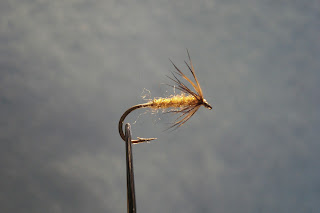 |
| This dressing follows William Blacker's substitution suggestion and uses a hackle from the head of a red grouse in place on a wren tail feather. |
Hook:
|
18-20
|
|
Thread:
|
Yellow
|
|
Body:
|
Yellow thread
|
|
Rib:
|
Gold twist
|
|
Hackle:
|
Small red feather on a red grouse’s head
|
|
Historically, anglers have dressed the Wren
Tail as a terrestrial imitation for the leafhopper, which naturally exhibits
ranging in color from a drab monochromatic to a vivid, improbable patterning
of colors.
Many author anglers include dressings for a Wren
Tail pattern, but only William Blacker in the Art of Angling (1843) includes a substitute for what, today, is a
taboo hackle. He relates a Wren Tail dressing that he received from a
Devonshire angler. Dressing this fly
calls for a “hook very small (midge). Body—yellow silk, and in some specimens
a little gold twist; hackle, either the wren’s tail feather . . . or the
small red feather on the cock grouse head.” Blacker’s own Wren Trail Fly is
more involved, larger, winged dressing.
Another useful substitute for wren tail besides the red grouse neck
hackle that Blacker specifies is evident in the hackling equivalent that James
Blades listed for his Wren Tail in a list of Blades’ patterns that Robert L.
Smith included at the end of his North
Country Fly: Yorkshire’s Soft Hackle Tradition (2015), available from Coch-y-Bonddu Books: Blades dressing equates hackle “from the outside of a quail wing” with
hackling from a “wren tail.” His dressing for the Wren Tail is
“Hook: No. 1 or 0
Silk: Orange
Body: Orange silk dubbed with red fur, and ribbed with
gold
Wings: From the outside of a quail wing or wren tail
(A good fly on blustery, showery days, when the fly gets
dashing into the water from overhanging growth)”
|
 |
| This dressing of John Kirkbride’s “clear water” Wren’s Tail follows Blacker’s substitution for hackle and a mix of olive hare’s ear and medium olive antron for the body. |
John Kirkbride includes the Wren’s Tail in his
Northern Angler (1837), calling it
“an excellent summer fly. The body, if the water be somewhat black, ought to
be of light orange mohair, tipt at the tail with a little gold wire or
tinsel; or, for clear water, a dusky olive body, tipt as above, suits
extremely well; a feather from a wren’s tail must be put round the head as a
hackle.”
|
 |
| For Alfred Ronalds’ Wren Tail, this dressing also follows Blacker’s hackle suggestion and uses tan acrylic for the body. |
In the Flyfisher’s
Entomology (1836), Alfred Ronalds dresses the Wren Tail as a summer
terrestrial, the Frog Hopper or Pale Brown Bent Hopper, dressed with a
“BODY. Ginger-coloured fur ribbed with gold twist.
WINGS AND LEGS. Feather from a wren’s tail.”
|
Neil
ReplyDeleteI used a pattern yesterday that looks similar to your Wren Tail and was able to land a couple of quality rainbow. Nothing else would produce but the soft hackle. The trout were barely breaking the surface and not feeding on top. The breaks at the surface were every 15 to 20 minutes and not consistent; the soft hackle was the only fly that would get any reaction. I was letting it drift just over the surface. Thanks for sharing
Thanks for sharing, Bill. Try greasing your soft hackle and twitch it at the end of the drift to break the surface film. They'll nail. They have on the Clinch during the sulfur hatch.
DeleteNeil
ReplyDeleteThanks for the advice, I will give it a try next week on the Sipsey.